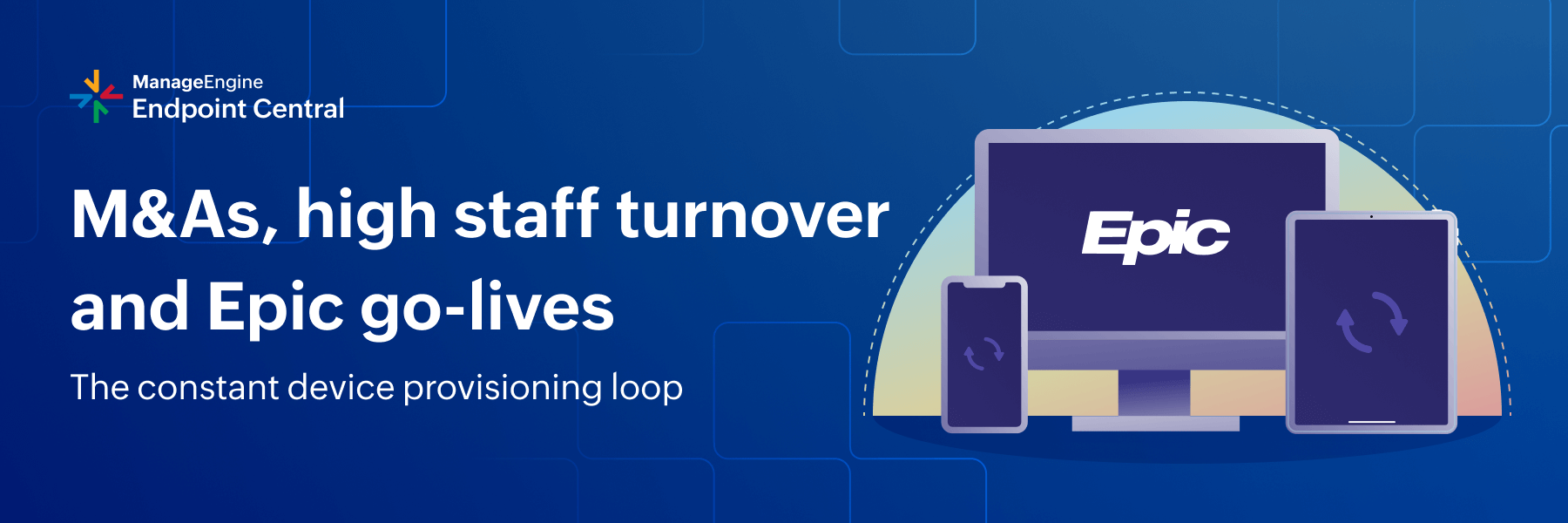Device provisioning struggles due to M&As, high staff turnovers, and Epic go-lives

Two primary trends are reshaping the healthcare industry: First, healthcare experiences a high number of mergers and acquisitions (M&As), with affiliates frequently joining and exiting as contracts evolve. Second, staff turnover remains persistently high, largely driven by burnout among healthcare practitioners. These dynamics have a common downstream effect on healthcare IT teams: constant provisioning and deprovisioning of devices so practitioners can deliver care—whether they’re integrating into a larger entity or onboarding as new hires.
This unending device provisioning cycle can be exhausting—and it shouldn’t create burnout for health IT teams, too. Manually imaging each device doesn’t scale. This is where automation helps. In fact, one Philadelphia‑based non‑profit healthcare organization reduced costs by $22,000 purely by eliminating manual effort.
Before we dive into the specifics behind the $22K savings, here’s a quick look at the trends driving it.
The M&A marketscape in healthcare
Healthcare has long been M&A‑intensive, and dealmakers who stay active tend to outperform. A Bain & Company study found that nearly 53% of healthcare and life science companies are frequent acquirers—the most rewarding strategy in the sector. As provider groups consolidate, the technology agenda follows: harmonize systems, unify clinical workflows, and standardize on a single EHR so information flows seamlessly across the new enterprise.
These ongoing M&As are a major reason Epic keeps gaining ground. In 2023, Epic was the only EHR vendor to grow its overall customer base; among 319 hospitals that adopted a new acute EHR, 77 chose Epic, and more than half of U.S. acute‑care beds now run on Epic. Smaller specialty practices are also being drawn in via programs such as Epic Community Connect to plug into hospital‑based Epic ecosystems—sharing both the cost of Epic and patient records. Epic go‑lives are intensive projects, often triggering device inventorying and refreshes.
You can read more about device onboarding challenges during EHR adoption here.
Staff turnover trends in healthcare
Meanwhile, turnover keeps operational pressure high. Even pre‑COVID estimates showed nurse and physician departure at concerning levels— 27.65% and 11% respectively. In the U.S., studies on healthcare worker burnout also highlight that improved EHR usability is critical to well‑being at work. This helps explain why hospitals are upgrading to more usable EHRs such as Epic as part of broader efforts to reduce burnout‑driven turnover.
How can you meet constant device provisioning demands?
Together, these trends translate into relentless device provisioning and deprovisioning for IT teams. Manual processes aren’t the answer. A solution like Endpoint Central can dramatically reduce the time required to image and configure devices.
A Philadelphia‑based non‑profit healthcare organization faced two acute challenges:
1. Constant staff turnover, forced frequent OS imaging to reprovision retired devices for new hires.
2. A major device replacement project retired legacy systems on a tight 30‑day deadline.

With Endpoint Central, they delivered on both at a fraction of the time, saving $22,000 in manual effort. The IT systems engineer who spearheaded the initiative chose Endpoint Central based on proven value from a previous role:
"In my previous organization, I was asked to image a computer. I said, ‘Oh! I’ll be gone for the next few hours,’ but the IT team there showed me a tool named Endpoint Central. They entered a code, and it was done instantly! I was blown away by how quickly it happened.”
- IT systems engineer, Philadelphia-based non-profit healthcare
To learn more about how this Philadephia based NPO was able to reduce device provisioning costs and consolidated multiple disjointed tools, read the case study.
If your organization is navigating a similar transition and you’d like to explore how Endpoint Central can help, get in touch with one of our product experts.
Additional resources
If you’re exploring how Endpoint Central can facilitate healthcare, feel free to check out these resources: